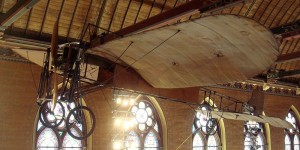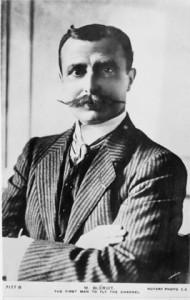A little after four o’clock in the morning this day 102 years ago, 30 year-old Louis Charles Joseph Blériot, an engineer and early French aviator, was nursing a badly burned foot. He and two other early pilots, Hubert Latham and Charles de Lambert, were analyzing the weather and other problems they faced for the first attempted crossing of the English Channel by an aircraft.
Earlier when he was flying his #VIII machine in preparation for the crossing, a fuel line broke causing the fire. Regardless of his injury, Blériot remained determined to fly across the English Channel. Blériot’s #VIII aircraft was his most successful design in addition to being his largest aircraft. With it damaged, his only choice was too quickly ready his #XI machine for the flight.
Blériot designed the Blériot #XI as a structurally strong aircraft. It was a light and maneuverable monoplane powered by a 25-horsepower Anzani engine. The little three-cylinder engine drove a fairly large, wooden fixed-pitch propeller.
Blériot manned his aircraft and took off just after dawn a little after 4:30 in the morning. Latham had overslept and did not realize Blériot had departed.

This is the plane on which Bleriot crossed the Channel. Photographed at the Musee des Arts et Metiers. / PHGCOM via Wikipedia
As Blériot climbed into the sky over the English Channel, he was flying an airplane whose engine could only develop 1200 rpm, flew just a bit over 40 miles per hour, and had no compass.
Assuming Blériot took off from the beach at Calais, France and flew a straight line to Dover, England, the distance is 25 miles. His flight through fog and bad weather, took 36 and one-half minutes. This gives an average speed across the water of 41 miles per hour.
When he arrived in Dover, Blériot made a very rough landing. The landing gear collapsed and the propeller struck the ground snapping in two. The damage was so thorough the airplane would never fly again. After a few quick repairs, the airplane went on display in a department store. It would later go on permanent display at the Musee des Arts et Metiers.
Even though the airplane crashed on arriving at Dover, the simple fact that Blériot made across the Channel allowed him to collect the prize money offered by the Daily Mail. It was the equivalent to approximately $5000 by today’s standards.
Because of his success at crossing the Channel, Blériot quickly gained fame as an aircraft designer and builder. He would go on to build and sell many of his #XI design. Indeed, by September 1909 Blériot had more than 100 orders for the airplane.
Blériot continued his work in aircraft design and construction. Leading up to World War I, he would become president of an aircraft company in trouble. The company was Société pour les Appareils Deperdussin, which he would later rename Société Pour Aviation et ses Derives (SPAD).
SPAD would go on to become a leader in the production of French combat aircraft. Additionally, France would export many of the aircraft to friendly countries.
After the war, Blériot formed his own company, Blériot-Aéronautique, for the production of commercial aircraft. He continued to work on other designs over the coming years.
On August 2, 1936, Blériot died of a heart attack at the age of 64.
-30-
©2011 J. Clark
Note: Email subscribers, please go to my blog to view vids and photos


Love the determination of Louis Bieriot. I love that he didn’t give up after his crash. Interesting read.
Jeanne